
* In the years between the Great Wars, aircraft designer Andrei Tupolev designed a series of bomber and transport aircraft for the Soviet state, gradually increasing in scale to the huge MAXIM GORKY, one of the biggest aircraft of the era -- with Tupolev planning even larger aircraft that weren't built. Today, these aircraft are generally forgotten footnotes to aviation history. This document describes the rise and fall of Tupolev's giants.
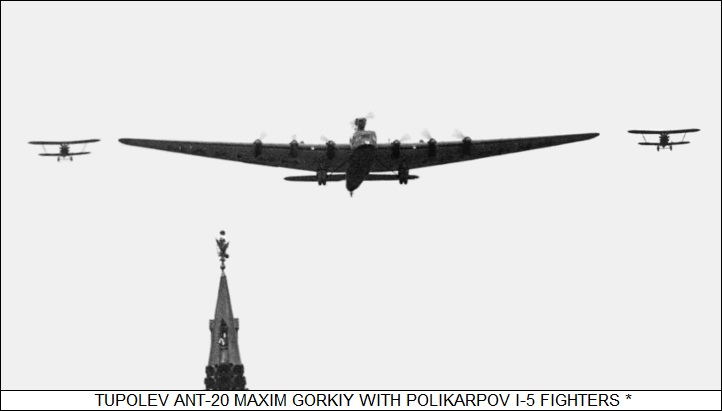
* Andrei Nikolayevich Tupolev was born in 1888 in the village of Pustomazovo, of aristocratic Cossack parentage. He graduated from the Moscow Higher Technical University in 1918, to find employment with the Central Aero-Hydrodynamics Research Institute (TsAGI in its Russian acronym) as an aircraft designer.
Tupolev's first project for TsAGI was the "ANT-1", of course named after his initials. It was a single-seat low-wing light sports monoplane, with taildragger landing gear and an open cockpit, powered by an Anzani engine with 26 kW (35 HP) driving a two-bladed fixed propeller. It was 5.4 meters (17 feet 8 inches) long, had a wingspan of 7.2 meters (23 feet 7 inches), and a typical flight weight of 360 kilograms (794 pounds). It was built largely of aircraft aluminum alloy, the aircraft being a demonstrator for construction with aluminum tubes, rivets, and corrugated sheet metal.
Initial flight was on 21 October 1923, with E.I. Pogossky at the controls; the engine failed after a few flights and the ANT-1 never flew again, the machine having fulfilled its purpose in life. It was stored and finally scrapped in 1937. The ANT-1 had never amounted to anything but an experiment, but it was a valuable one, and also marked the birth of Tupolev's experimental design bureau (OKB in its Russian acronym), which would have a long and illustrious history.
Following up the ANT-1, in 1923 the Red Air Force (Voyenno Vozdushniye Sily / VVS) requested development of a single-engine aircraft of metal construction that could be used as a light personnel transport or for reconnaissance. The result was the "ANT-2" monoplane, which was a comical-looking aircraft, with a high wing; taildragger landing gear; a Bristol Lucifer three-cylinder air-cooled radial engine providing 75 kW (100 HP) and driving a two-bladed fixed prop; an open cockpit mounted forward of the wing; and a deep-bellied fuselage, with a door on the side and seats for two passengers.
The ANT-2 had a length of 7.6 meters (24 feet 11 inches), a span of 10.45 meters (34 feet 4 inches), and a loaded weight of 840 kilograms (1,850 pounds). Initial flight was on 26 May 1924, with N.I. Petrov at the controls. An initial production batch of five "ANT-2bis" machines -- "bis" being Latin / French for "encore" and loosely translating as "plus" -- was planned, to be powered by the US Wright Cyclone radial with 150 kW (200 HP), but only one was built, and no reconnaissance configurations were produced. The type ended up being another educational exercise for Tupolev. The ANT-2 still survives on static display at Monino near Moscow.
* Although the ANT-2 was another dead end, by the time it was in the air, the Tupolev OKB was already working on an "ANT-3", a two-seat reconnaissance aircraft, to be powered by an American Ford Liberty water-cooled V8 engine with 300 kW (400 HP). It was to be armed, and be used in a secondary close-support role. Initial flight of the prototype was on 10 July 1925, with V.N. Filippov at the controls. Following construction and flight of a second prototype, the type was put into production at a state factory in Moscow. Initial production examples of the "R-3" -- that being its service designation, the "R" standing for "razvedchik (reconnaissance) -- were delivered in 1927 -- these aircraft being powered by the M-5 engine, a Soviet version of the Liberty.
The R-3 was an ordinary two-seat biplane of the era, its major distinction being its metal construction. It had tailskid landing gear and two open cockpits, in tandem behind the wing. It had armament of a single 7.62-millimeter (0.30-caliber) PV-1 machine gun fixed to fire forward; twin 7.62-millimeter DA machine guns on a ring mount around the rear cockpit; and underwing racks for up to ten small bombs. Length was 9.89 meters (32 feet 5 inches), wingspan was 13 meters (42 feet 8 inches), and typical weight was 2,090 kilograms (4,610 pounds).
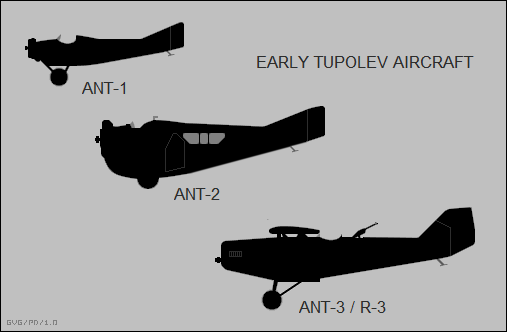
After manufacture of 21 R-3 machines, production was changed to the Lorraine-Dietrich 12Eb vee-12 engine with 335 kW (450 HP), this variant being designated the "R-3LD". 79 were built up to 1929, for a total of 103 R-3 aircraft of all variants; it should be noted that VVS records give larger totals. A single example of an improved derivative, the "ANT-10 / R-7", was flown in 1930, but the VVS preferred the cheaper wooden Polikarpov R-5 for the reconnaissance role.
The VVS used R-3 aircraft for attacks on anti-Soviet insurgents in Central Asia in the early 1930s. 30 R-3s were modified as mailplanes for Aeroflot, the state airline, and designated "PS-3", where "PS" stood for "pochtoviy samolyot (mailplane)". The R-3 was generally out of service by the mid-1930s. By that time, the Tupolev OKB was increasingly focusing on larger and larger aircraft.
BACK_TO_TOP* While Tupolev was working on the R-3, his OKB was also working on a bomber of all-metal construction. The first of two prototypes of the "ANT-4" performed its initial flight on 25 November 1925, with test pilot A.I. Tomashevskiy at the controls. The second prototype, much closer to operational spec, flew in 1928, with the type being accepted into VVS service in 1929 as the "TB-1". To show off the new aircraft, in the fall of 1929 an unarmed TB-1 flew from Moscow to New York City via Siberia, arriving on 3 November after a flight of 137 hours.
The TB-1 owed much to design concepts used by German aircraft maker Hugo Junkers. To the modern eye, the TB-1 was a "crate", with a boxy fuselage, open cockpits and gun positions, a low wing with twin engines, a conventional tail arrangement, and fixed taildragger landing gear, all gear assemblies with single wheels. It was, however, a very advanced aircraft of its day, with leading-edge performance. It was powered by Mikulin M-17 vee-12 water-cooled engines with 510 kW (680 HP) each, driving two-bladed propellers; the M-17 was a Soviet-built version of the German BMW VI vee-12, which powered the second prototype and early production machines. The first prototype had been powered by British Napier Lion 12-cylinder "arrowhead" engines, with three banks of four cylinders.
Defensive armament seems to have originally consisted of three Degtyarev DA 7.62-millimeter machine guns on ring mounts, with two staggered positions in the rear and one in the nose. The TB-1 is better known to have dual gun mounts, with six DA machine guns, that fit presumably introduced in later production. It appears to have had a small bomb bay, but stores were more generally carried externally under the belly and wings; total warload is given as a tonne (1.1 tons). A belly external tank could be fitted to extend range.
___________________________________________________________________
TUPOLEV ANT-4 (TB-1):
___________________________________________________________________
wingspan:
28.8 meters (94 feet 6 inches)
wing area:
115.8 sq_meters (1,245 sq_feet)
length:
18 meters (59 feet 1 inch)
height:
6 meters (19 feet 8 inches)
empty weight:
4,520 kilograms (9,965 pounds)
MTO weight:
6,810 kilograms (15,015 pounds)
max speed at altitude:
200 KPH (125 MPH / 110 KT)
service ceiling:
4,700 meters (10,365 feet)
range:
1,000 kilometers (620 MI / 540 NMI)
___________________________________________________________________
Crew was five, including two gunners in the rear dorsal positions; pilot and copilot in a side-by-side cockpit; and gunner / bombardier in the nose position, the nose featuring glazing for bomb-aiming. The TB-1 could be fitted with skis for winter operation, and was rigged with floats for service with the AVMF (Red Navy air arm). The AVMF floatplane machines were designated "TB-1P" and could carry a single torpedo externally, as an alternative to more conventional stores.
* A total of 216 TB-1 machines was built into 1932, 66 of them being TB-1P floatplanes for the AVMF. The TB-1s remained in first-line service as combat types into the mid-1930s, survivors being used in a dwindling fashion as transports, designated "G-1", after that. The G-1s were used both by the VVS and the GVF, the civil air fleet, which later became the state airline Aeroflot. VVS G-1s retained armament, while GVF machines were unarmed; at least some G-1s were fitted with enclosed cockpits.
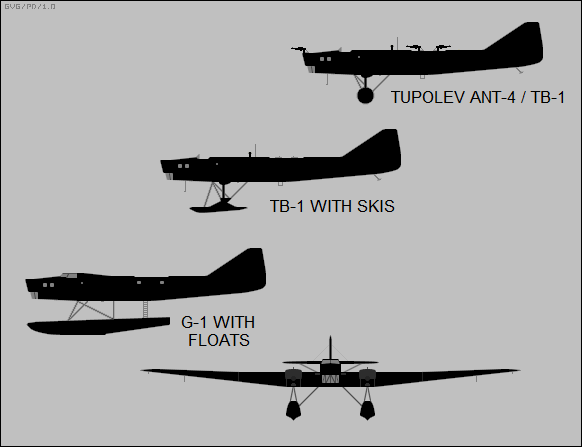
The TB-1 was also used for various trials. In 1931, a dozen were experimentally flown in evaluation of various interesting schemes for transporting troops, with photos showing a belly cargo pod, along with a belly external tank; a belly personnel transport pod; and various gear strapped onto the bottom, such as a tankette, artillery piece, or staff car. It is unclear if G-1s ever carried the pods in practice, but it seems plausible that strap-on stores were hauled operationally, since doing so required little or no specialized kit.
Other trials included tests of "rocket-assisted take-off (RATO)" gear; firings of unguided rockets; experiments with inflight refueling; one machine converted to radio control as a flying bomb; and a "flying aircraft carrier", discussed briefly at the end of this document. There was work on an "ANT-19" airliner based on the TB-1, but the effort was abandoned without building a prototype.
TB-1s had their baptism of fire in a border clash with China in 1929. In the mid-1930s, they participated in a series of dashing Arctic search and rescue operations. Relegated to the transport role, they saw service in the Russo-Japanese border clashes of 1938 and 1939, as well as the "Winter War" with Finland in 1940. G-1s saw good use in the USSR's war with Germany from 1941 to 1945, one function being to haul supplies, sometimes in gliders, to partisan forces behind German front lines. The G-1 lingered in service as a backwoods cargo hauler for some years after the conflict. One G-1 survives on static display.
BACK_TO_TOP* The ANT-4 / TB-1 proved so satisfactory that there was an immediate push to make something bigger and better to follow it, with the Tupolev OKB simply generating a design of what was effectively a TB-1 with stretched dimensions, and four engines instead of two. Work on the "ANT-6" began in the fall of 1929, with initial flight of the first prototype on 22 December 1930, Mikhail M. Gromov at the controls. The ANT-6 was accepted by the VVS the next year as the "TB-3", with initial production deliveries in 1932 -- in time for a batch to perform an overflight for the annual Moscow May Day parade.
The TB-3 looked so much like a TB-1 with four engines that it's hard not to think there was considerable compatibility in assemblies between the two designs. The arrangement of fuselage positions for five crew were generally the same, with a nose position featuring twin DA guns on a ring mount; side-by-side open cockpit for pilot and copilot; and two positions on the rear fuselage, each with ring mounts for two DA guns. However, there was also a position under each wing, between the inboard and outboard engines, with a single rearward-firing DA gun, raising the number of crew to seven. The details of the underwing positions are obscure; it appears a gunner went out to the position through a tunnel in the wing, with the gun position being retractable. Crew being given as eight in some sources, it is possible that the TB-3 also included a navigator, such being necessary for long-range bombing missions.
There were other distinct differences from the TB-1, the TB-3 featuring a revised tail assembly with a tall tailfin; and dual wheels, in tandem, for each main gear assembly. Skis could be fitted, though it doesn't appear anyone tried to fit the TB-1 with floats -- it would have been of questionable practicality for such a large aircraft. It doesn't appear that the naval AVMF ever used the TB-3 in any numbers.
Powerplants for the initial prototype were Curtiss Conqueror water-cooled vee-12 engines -- in that period, it seemed Soviet aircraft used whatever engines that could be begged, borrowed, or stolen -- but initial production had the Mikulin M-17, with more than half of the TB-3s built featuring that engine. Later production featured the more powerful Mikulin M-34 follow-on, with 600 kW (800 HP); in any case, the engines drove two-bladed fixed-pitch wooden props. The TB-4 had a small bomb bay, but most munitions were carried externally, running to a total load of 2,000 kilograms (4,400 pounds).
___________________________________________________________________
TUPOLEV ANT-6 (TB-3):
___________________________________________________________________
wingspan:
39.5 meters (129 feet 7 inches)
wing area:
230 sq_meters (2,474 sq_feet)
length:
24.4 meters (80 feet)
height:
8.45 meters (27 feet 9 inches)
empty weight:
11,200 kilograms (24,690 pounds)
MTO weight:
19,300 kilograms (42,500 pounds)
max speed at altitude:
175 KPH (110 MPH / 95 KT)
service ceiling:
3,800 meters (12,465 feet)
range:
1,350 kilometers (840 MI / 730 NMI)
___________________________________________________________________
The M-34 engine was upgraded to the M-34R with reduction gear, and then the further improved M-34RN; experiments were performed with supercharged M-34RNs and AN-1 diesels, but such configurations did not enter production. Later machines had four-bladed fixed-pitch props on the inboard engines, and a large single wheel on each main gear assembly, instead of two wheels.
There was considerable variation in armament configuration through the TB-3's production life:
After the end of its service life as a bomber, the TB-3 was pressed into service with both the VVS and Aeroflot as a transport, using the designation of "G-2" -- the Aeroflot machines being unarmed, the VVS machines often being used as paratroop transports. Airliner versions had 50 seats; cargoes could be carried in underwing pods. Enclosed cockpits were fitted to at least some G-2s, and may have been fitted to TB-3s as well. There were also special G-2 fits for Aeroflot Arctic work, named the "AviaArctika", with a tidier enclosed cockpit and nose glazing, plus three-bladed props.

The last of 818 TB-3s were rolled out in 1938. In the prewar days, the TB-3 established a number of distance records and was used on long-range Arctic rescue missions. They were used as bombers in the Far East in the 1938 and 1939 Russo-Japanese border clashes, and in the Winter War against Finland in 1940. After the German invasion in 1941, the TB-3 performed day bombing attacks but suffered heavily, to then be switched to night bombing. It was soon relegated to the transport role, which it served with distinction through the conflict. No doubt some lingered in the postwar period; it doesn't seem any have survived to the present day.
BACK_TO_TOP* While Tupolev was developing a scaled-up derivative of the TB-1, he was also working on a scaled-down derivative, the "ANT-7". The primary rationale behind it was as an "air cruiser" -- in effect, a heavy escort fighter for bombers -- though it could also be used for other roles. The initial flight of the prototype was on 11 September 1929, with Mikhail Gromov at the controls. After trials, the type was approved for production as the "R-6", a reconnaissance variant; and the "KR-6", an air cruiser variant -- where "KR" stood for "kreyser (cruiser)".
As it emerged, the R-6 looked so much like the TB-1 as to be easily confused with it, being an all-metal monoplane with a low wing, twin engines, and fixed taildragger landing gear -- single wheels on the main gear assemblies, a tailskid in the rear. It was powered by M-17 engines driving two-bladed fixed-pitch props; and had open crew positions in the nose, for the pilot, and in a dorsal position. The R-6 was, however, smaller than the TB-1, with an empty weight 85% as great; it also had a single-seat cockpit, and only a single dorsal gun position.
___________________________________________________________________
TUPOLEV ANT-7 (R-6):
___________________________________________________________________
wingspan:
23.2 meters (76 feet 1 inch)
wing area:
83.96 sq_meters (903.3 sq_feet)
length:
15.06 meters (49 feet 5 inches)
height:
5.45 meters (17 feet 10 inches)
empty weight:
3,855 kilograms (8,500 pounds)
loaded weight:
6,470 kilograms (14,265 pounds)
max speed at altitude:
215 KPH (135 MPH / 115 KT)
service ceiling:
6,050 meters (19,850 feet)
range:
1,680 kilometers (1,045 MI / 905 NMI)
___________________________________________________________________
Defensive armament was a single PV-2 7.62-millimeter machine gun in the nose and dorsal positions; that was meager armament, but it seems there were experiments with carriage of 37-millimeter cannon, but that configuration did not go into production. Oddly, most photos of the ANT-7 do not show it to be armed. Up to 200 kilograms (440 pounds) of bombs could be carried.
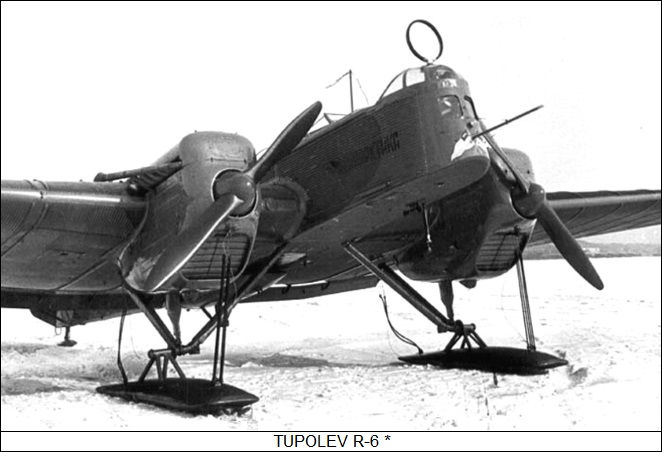
A floatplane version, the "MR-6", was built for the AVMF. A number of ANT-7s were converted to a transport configuration, designated "MP-6", with an enclosed cockpit and raised passenger section, with a VIP version featuring more windows also built by conversion. A total of 407 ANT-7s of all subvariants was produced up to end of production in 1936. The ANT-7 served primarily in the transport role through World War II.
A heavily armored ground-attack variant, the "ANT-18", was considered; it didn't happen. There was also consideration of a follow-on, the "ANT-30", of the same broad configuration -- similar size, all metal construction, low wing, twin engines -- but with much refined aerodynamics, retractable landing gear, and enclosed positions. However, it never flew either, the "cruiser" concept having rightly been recognized as a dead end.
BACK_TO_TOP* In 1927, Tupolev was tasked with development of an airliner, the design emerging as the "ANT-9", the prototype performing its initial flight in May 1929, Mikhail Gromov at the controls, the machine having been first put on static public display in Red Square for the May Day celebrations. Manufacture had already been approved, with production aircraft following.
The ANT-9 prototype was very much along the lines of the Dutch Fokker and US Ford trimotor airliners, being a boxy all-metal high-wing aircraft with fixed taildragger landing gear -- single wheels on the main gear, tailskid in the rear. It was powered by triple Gnome-Rhone Titan 5Va five-cylinder radial engines, one in the nose and one mounted in front of each wing, with 170 kW (230 HP) and driving two-bladed wooden propellers. It had a crew of two and a capacity of 9 passengers, with a passenger door on the rear of the left side of the fuselage and a baggage hold door further back on the rear of the right side of the fuselage. The resemblance to the Fokker and Ford trimotors was somewhat misleading, since the ANT-9 owed a good deal to the ANT-7 in its engineering specifics.
Production machines were supposed to have Wright Whirlwind seven-cylinder radials, but engine availability was problematic; although other radial fits were considered and in some cases evaluated, the decision was made to use twin M-17 vee-12 engines instead of three radials -- the engine installation being inherited from the ANT-7, the nose space freed up by deletion of the forward engine being used as a baggage hold. The twin-engine machines were designated "PS-9", where "PS" stood for "passazheerskiy samolyot (passenger plane)". It is unclear how many production machines had the trimotor configuration, but they were a minority.
___________________________________________________________________
TUPOLEV PS-9:
___________________________________________________________________
wingspan:
23.72 meters (77 feet 10 inches)
wing area:
84.91 sq_meters (913.5 sq_feet)
length:
17.01 meters (55 feet 10 inches)
height:
5.06 meters (16 feet 7 inches)
empty weight:
4,400 kilograms (9,700 pounds)
MTO weight:
6,200 kilograms (14,550 pounds)
cruise speed:
200 KPH (125 MPH / 110 KT)
service ceiling:
5,100 meters (16,725 feet)
range:
700 kilometers (435 MI / 380 NMI)
___________________________________________________________________
The number of ANT-9s built is given as anywhere from 75 to 100, depending on source. ANT-9s were on occasion fitted with skis for winter operations, and at least one was fitted with floats. There were tinkerings with bomber and air ambulance configurations; one twin-engine variant was rigged up for the Maxim Gorkiy propaganda squadron, to promote the KROKODIL (Crocodile) humor magazine -- featuring a "snout" with jaws painted on and a series of ridges on its back to impersonate a crocodile. The ANT-9 served through World War II, it seems primarily as a VIP transport, and may have lingered for a time afterward.
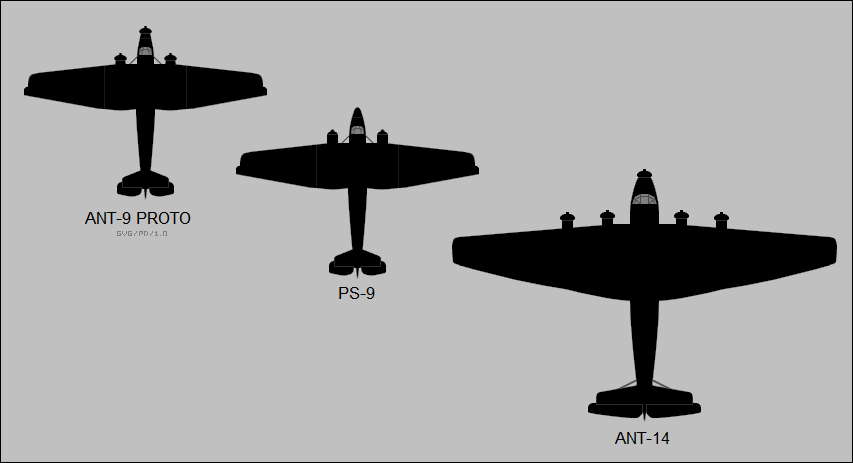
* In 1929, Tupolev was tasked with the construction of a long-range airliner with 32 seats for the Moscow to Vladivostok route. The "ANT-14" performed its first flight on 14 August 1931, Gromov at the controls. The ANT-14 was effectively a scaled-up ANT-9, with five radial engines instead of three, all imported Gnome-Rhone Jupiter VI radials with 360 kW (480 HP) each, driving two-bladed fixed-pitch props. It actually leveraged off the ANT-6 / TB-3 in its construction, one big hint being the two-wheel tandem main gear, though that was later switched to single-wheel main gear.
___________________________________________________________________
TUPOLEV ANT-14:
___________________________________________________________________
wingspan:
40.4 meters (132 feet 5 inches)
wing area:
84.91 sq_meters (913.5 sq_feet)
length:
26.41 meters (86 feet 7 inches)
height:
5.4 meters (17 feet 8 inches)
empty weight:
10,650 kilograms (23,480 pounds)
MTO weight:
17,146 kilograms (37,800 pounds)
cruise speed:
200 KPH (125 MPH / 110 KT)
service ceiling:
4,220 meters (13,840 feet)
range:
900 kilometers (560 MI / 485 NMI)
___________________________________________________________________
The ANT-14 flew very well, with the decision made to fit it with 36 seats instead of 32. However, it was not put into production, projected growth in airline passenger traffic not being seen as justifying the manufacture of such a large aircraft. The prototype was put into service with the Maxim Gorkiy propaganda squadron, being used to promote the state newspaper PRAVDA (TRUTH). After the end of its flying life, it was sited in Moscow's Gorkiy Park, to be used as a movie theater.
BACK_TO_TOP* Even as Tupolev was getting the ANT-6 / TB-3 into production, the VVS was pushing for an even heavier bomber, essentially a scaling-up of the ANT-6, powered by four Mikulin M-35 vee engines with 930 kW (1,250 HP) each. However, in the course of development of the "ANT-16", as it was designated, it became apparent that the M-35 wasn't going to be available, so the decision was made to fit the aircraft with six M-34 engines -- the added two being placed in a pod as a tractor-pusher pair on the back of the aircraft. The ANT-16 performed its first flight on 3 July 1933, of course with Gromov at the controls.
Except for the tandem engine pod on the back, the ANT-16 looked very much like a bigger TB-3, with the same general configuration as a later production TB-3 -- low-wing all-metal monoplane with fixed landing gear; open side-by-side cockpit; open gun positions in nose, dorsal area, and tail. The ANT-16 had dual wheels on each main gear, in a side-by-side configuration, and a proper tailwheel instead of a skid. It had a capacious bomb bay, the notion of carrying most stores externally having gone out of fashion by that time. Length of the ANT-16 was 32 meters (105 feet), wingspan was 54 meters (177 feet 1 inch), and empty weight was 21,400 kilograms (47,180 pounds) -- almost twice as much as the TB-3. Performance was very similar to the TB-3.
There was consideration of moving on to production of the ANT-16 as the "TB-4", but the VVS was wisely having second thoughts about the utility of big lumbering vulnerable bombers, increasingly believing that better performance was more desireable than sheer size. The ANT-16 program was abandoned in 1934, a second prototype never being finished. The first prototype was used for various trials, including toting a light tank around, and it appears finally scrapped.
* Although the ANT-16 was a nonstarter, the sheer scale of the aircraft had propaganda appeal, and so the idea was born to create an even larger commercial derivative for propaganda purposes, the pretext being to commemorate revolutionary author Maxim Gorkiy. The new design, the "ANT-20", leveraged heavily off the ANT-16, but had higher payload weight and -- in accordance with its mission to spread the Red word across the USSR -- the ability to operate off airfields half the length of those required by the ANT-16. The ANT-20 design allowed the aircraft to be fitted out as a proper airliner, as well as a bomber or flying command post.
The uncompleted second ANT-16 prototype was used as a source of assemblies to build the ANT-20. The MAXIM GORKIY, as it was of course named, performed its initial flight on 17 June 1934, with Gromov yet again at the controls, who reported that it handled very nicely. It was handed over to the Maxim Gorkiy propaganda squadron that August. It had a clear resemblance to the ANT-16, the fuselage being only slightly longer, but of course lacked defensive armament. It had a larger wing and two more M-34 engines, with six on the wing leading edges, and two in the tandem pod on the aircraft's back. The dual side-by-side main landing gear was enclosed in oversized spats.
The ANT-20 was one of the first Soviet aircraft with an autopilot. It was fully fitted for the propaganda mission, carrying a radio broadcast transmitter, loudspeakers, floodlights, a little movie theater, and a library. It had rooms in the inner wings; there was an observation gondola on top of each wing near the middle engine and a gondola on top of the fuselage near the engine pod, presumably to allow the fight engineer to inspect engine operation in flight. The MAXIM GORKIY also had a generator that produced both DC and AC power.
The ANT-20 unsurprisingly set world aircraft payload records, but it didn't live to be a year old. On 18 May 1935, the ANT-20 was on a demonstration flight over Moscow, with three other aircraft in the flight. A Polikarpov I-5 fighter that was part of the group collided with the MAXIM GORKIY while performing a stunt loop around it; all aboard both planes, 45 people in total, were killed.
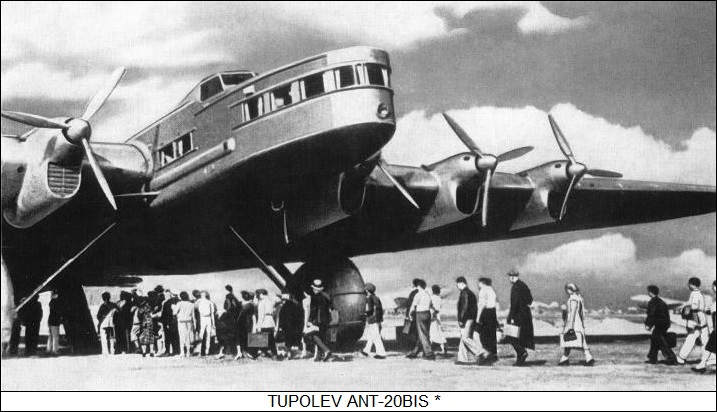
* That wasn't the end of the matter, however, with work then begun on a replacement, to be named the "ANT-20bis". It was generally similar to the original ANT-20, but had more powerful M-34FRNV engines that allowed the deletion of the clumsy tractor-pusher engine pod. It was configured as a 64-seat airliner, with few or none of the propaganda bells and whistles carried by its predecessor.
___________________________________________________________________
TUPOLEV ANT-20BIS (PS-124):
___________________________________________________________________
wingspan:
63 meters (206 feet 8 inches)
wing area:
486 sq_meters (5,228 sq_feet)
length:
34.1 meters (111 feet 10 inches)
height:
10.85 meters (35 feet 7 inches)
empty weight:
28,500 kilograms (62,700 pounds)
MTO weight:
42,000 kilograms (92,600 pounds)
max speed at altitude:
275 KPH (170 MPH / 150 KT)
service ceiling:
7,500 meters (24,600 feet)
range:
1,000 kilometers (620 MI / 540 NMI)
___________________________________________________________________
The ANT-20bis AKA "PS-124" performed its first flight on 15 May 1939, with pilot E.I. Shvarts at the controls. There were plans to build more, as well as consideration of bomber and paratroop versions, but none of it happened. After the outbreak of war, the ANT-20bis was refitted with AM-35 engines, being used to haul freight and passengers in Central Asia. It was lost near Tashkent on 14 November 1942, all 36 on board being killed, the accident apparently being due to pilot error.
* The ANT-20 / ANT-20bis was the end of the road for the Tupolev giants, though the organization did consider a super-giant bomber, the "ANT-26 / TB-6". It would have been a monster, with a length of 39 meters (128 feet), a span of 95 meters (311 feet 7 inches), and a range of 3,300 kilometers (2,050 miles) with a 15,000-kilogram (33,075-pound) bombload. It would have been powered by twelve M-34 engines -- four on the leading edge of each wing, two in a tandem tractor-trailer pod above each wing. The ANT-26 fairly bristled with gun positions, including one on the outboard leading edge and on the rear of each wing.
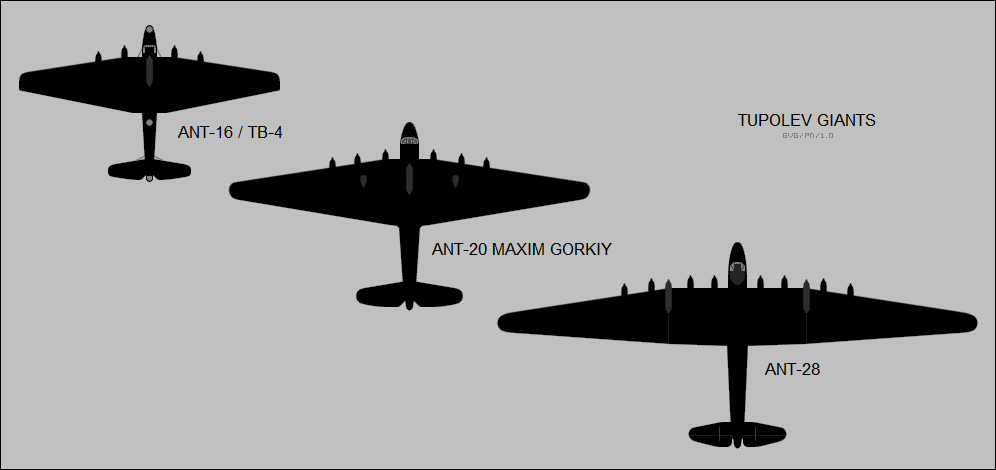
Work on a prototype was in progress when the exercise was abandoned in 1934. As clumsy as the ANT-26 looks to the modern eye, it seems a bit of a pity it never flew; it would have been an enduring symbol of Stalinist megalomania. An airliner version, the "AN-28", was considered, but never amounted to any more than a paper project. In any case, though the Tupolev giant flying crates were a dead end, they were leading edge for their time, and gave the Tupolev organization experience for building better designs.
BACK_TO_TOP* As Tupolev continued to reach for the heights in aircraft size, his OKB was also working to extend aircraft range. In late 1931, Tupolev submitted a proposal for an aircraft with three crew, a range of 12,000 kilometers, and a flight endurance of 80 hours. The authorities approved the "RD (rekord dalnosti / range record)" effort, with work begun on the "ANT-25" in June 1932 -- the effort being under Pavel Sukhoi, who would eventually acquire his own design bureau. Two were built, the first -- "ANT-25-1" or "RD-1" -- performing its first flight on 22 June 1933, the second -- "ANT-25-2" or "RD-2" -- taking to the air on 10 September, Mikhail Gromov doing the honors.
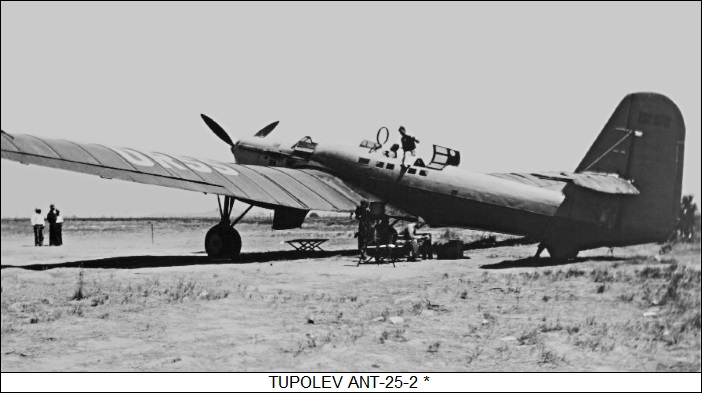
The ANT-25 was an all-metal, single-engine, low-wing monoplane with retractable taildragger landing gear. It was effectively a very large powered sailplane. The RD-1 originally had an M-34 engine with a two-bladed prop; the RD-2 had a geared M-34R with a three-bladed prop, with the RD-1 later updated to RD-2 spec. The tapered wings had an aspect ratio of 13; the main gear had dual wheels that retracted straight back into the wings, while the tailwheel was fixed. The aircraft had large fuel and oil tanks. Presumably there were relief facilities for the crew, but sources are unclear on that issue.
___________________________________________________________________
TUPOLEV ANT-25 (RD):
___________________________________________________________________
wingspan:
34 meters (111 feet 7 inches)
wing area:
87.1 sq_meters (938 sq_feet)
length:
13.4 meters (44 feet)
height:
5.5 meters (18 feet 1 inch)
empty weight:
3,700 kilograms (8,155 pounds)
loaded weight:
8,000 kilograms (17,635 pounds)
max speed at altitude:
245 KPH (150 MPH / 130 KT)
service ceiling:
7,500 meters (24,600 feet)
range:
7,200 kilometers (4,475 MI / 3,890 NMI)
___________________________________________________________________
The ANT-25 promptly set a series of long-distance records, leading to a pair of daring over-the-pole flights to North America. The first departed on 18 June 1937, arriving in Vancouver, Washington, after 63 hours 16 minutes in the air, having flown 9,130 kilometers (5,670 miles). The second flight departed on 12 July 1937, arriving at San Jacinto, California, after 62 hours 17 minutes in the air, having flown 11,500 kilometers (7,140 miles). The two flights attracted considerable world attention -- though the record only lasted a year, the British performing a flight from Egypt to Australia in Vickers Wellesley bombers in November 1938, covering a distance of over 11,520 kilometers (7,160 miles). In 1989, the Tupolev organization built a replica as a museum display; some sources hint a second replica was built as well.
* An "ANT-36" AKA "DB-1", where "DB" stood for "Dalniy Bombarovshchik (Long-Range Bomber)", was produced, as a minimum-change derivative of the ANT-25, with a warload of 1 tonne (2,200 pounds), and with defensive armament of twin flexibly-mounted DA machine gun positions -- armament is given in some sources as four guns, so they may have been dual gun mounts in some cases, the position of the guns being unclear. It was also fitted with a film camera. Only 18 ANT-36s were built, and its service life was brief.
A twin-engine derivative, the "ANT-37" AKA "DB-2" was built as well, with higher performance but much less range, initial flight of the first prototype being on 15 June 1935, K.K. Popov at the controls. The general airframe configuration was similar to that of the ANT-25, except for twin Gnome-Rhone Mistral Major K-14 14-cylinder two-row radial engines with 595 kW (800 HP) each -- originally driving two-bladed wooden propellers -- and nose glazing as per a proper bomber.
The ANT-37 had a length of 15 meters (49 feet 2 inches), a span of 31 meters (101 feet 8 inches), an empty weight of 5,855 kilograms (12,910 pounds), a maximum speed of 340 KPH (210 MPH), and a range of 5,100 kilometers (3,100 miles). It had a crew of three, could carry up to 2,000 kilograms (4,400 pounds) of warload, half of it internally, and had defensive armament of three ShKAS machine guns -- the actual arrangement of the guns again being unclear.
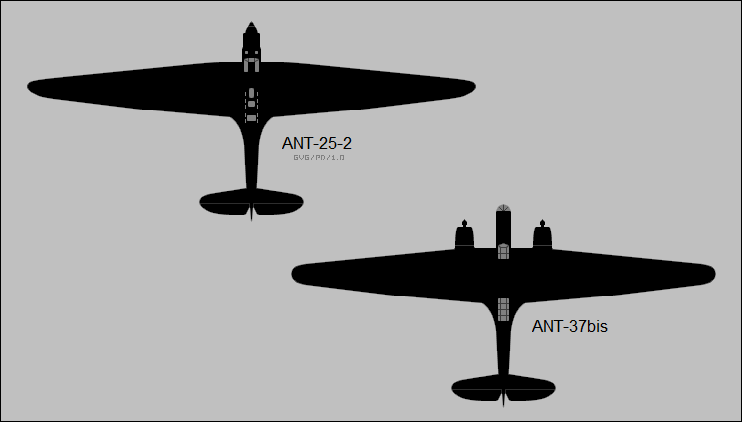
The first prototype crashed on 20 July 1935 when the tail broke off, one of the crew being killed. A second prototype -- with a reinforced fuselage -- was then built, but it flunked state trials due to severe flutter, with the program then being given up, with plans for production canceled. However, a third machine was completed as the "ANT-37bis" for setting records -- being stripped of armament, given with additional fuel tanks, and fitted with M-86 radials providing 640 kW (860 HP) driving three-bladed variable-pitch props. It was given the name RODINA (Motherland), and used to set a women's distance record. It remained in service into 1943.
BACK_TO_TOP* As a footnote to the story of the Tupolev giants, in the prewar years the TB-1 and TB-3 bombers were used in experiments conducted by one Vladimir Vakhmistrov as "flying aircraft carriers", hauling around fighters for launch in midair. There was a bit of tinkering with mid-air recovery in the program, but it wasn't fundamental to the scheme. Such "composites" were used to a limited extent early during World War II on the Eastern Front, with TB-4s carrying twin Polikarpov I-16 fighters rigged as dive-bombers, for long-range attacks. The issue is discussed elsewhere on this site, along with other "parasite fighter" concepts. Certainly, it provides a distinction to the career of an aircraft that would otherwise only be dismissed as an antiquated crate.
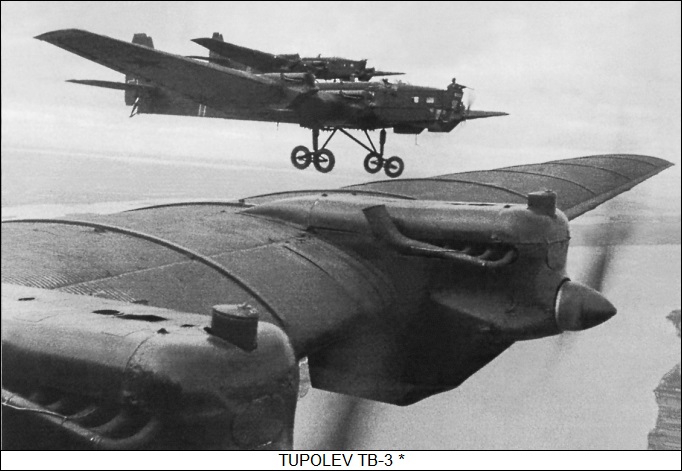
* Sources include:
The online Wikipedia was also consulted for details. These aircraft are not heavily documented.
* Revision history:
v1.0.0 / 01 jun 15 v1.0.1 / 01 may 17 / Review & polish. v1.0.2 / 01 apr 19 / Review & polish. v1.0.3 / 01 feb 21 / Review & polish. v1.0.4 / 01 dec 22 / Review & polish. v1.0.5 / 01 nov 24 / Review & polish. (*)BACK_TO_TOP
